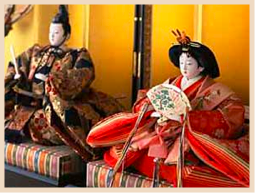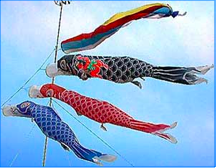
Todd Jay Leonard, Blog


“Hina Matsuri,” or “Girls’ Day,” is a doll festival held every year on March 3 in Japan. This celebration recognizes everything girlish, allowing little girls to be little girls.
A common practice is for girls to dress up in traditional kimonos to entertain their friends with special treats: “hishimochi” (diamond-shaped rice cakes). The idea is to sit and admire the meticulously displayed doll collection arranged on a multi-tiered platform. These dolls are never played with in the bathtub or the sandbox. They are much too delicate to be touched routinely.
A complete collection usually has around 15 dolls. The two main dolls, representing the emperor and empress, are always placed on the top tier dressed in traditional court costumes, flanked on both sides by miniature lanterns, with beautiful gold screens behind them. Arranged on the lower levels is their retinue: attendants, handmaidens and court musicians.
Interspersed on each of the lower levels are accouterments associated with the emperor and empress — chests, tables with food, musical instruments, and even an ox-drawn carriage.
Frequently a little girl’s doll set is given to her by her mother, who had hers given to her by her mother. It is often a generational heirloom, with each new owner adding to the collection. It is displayed much like a Christmas tree is in that it is only to be admired, not touched, and stays set up for around two weeks before it is taken down. It is then carefully packed away until the next year when the process is repeated.
During this season, many department stores have doll sets for sale. I was shocked at how expensive it is to purchase a complete set. The prices ranged from $2,000 to several thousand dollars. This is why many families combine older pieces that have sentimental value with newer pieces as little girls are born into the family.
Neighbors once invited me to their home to partake in this celebration. The little girl, around 5 years old, was so proud to show me her collection. She pointed out each piece, explaining who and what it was. We all then sat and had refreshments while gazing at this most spectacular display of craftsmanship and tradition.
Not to be left out, boys also celebrate their own day in Japan on May 5 every year (also called “Children’s Day”). To mark this day, families who have boys fly huge carp-shaped streamers on poles outside their homes. These banners are called “koinobori” in Japanese and represent manly virtues, because the carp is such a hardy and gallant fish.
The tradition is actually Chinese in origin and is related to a Chinese myth about a carp that swam upstream and magically became a dragon. Japan had long considered the carp to be special in its own lore, so this just added to its appeal.
The size and number of carp banners flying outside a Japanese home represents the age and number of boys living in the household. Of course, the longest streamer (up to 15 feet in length) symbolizes the oldest son, the next biggest size, is the second son and so on. Even people who live in apartments will display shorter versions in graduated order according to how many sons the family has.
I have also heard the story that the carp represent the father, mother and son — the father carp being the biggest, the next being the mother, and the small one, the son. A friend told me that he remembers singing a song in kindergarten about the three carp and how they represent the family.
In recent years, some modern Japanese families have adapted the custom to include all of their children by displaying a flag for each child — not only for sons but also for daughters. Purists, of course, stick to the segregation of the sexes, celebrating Girls’ Day with dolls, and Boys’ Day with flying carps.
Both events are spectacular in different ways. The dolls are exquisite examples of master craftsmanship and the carp streamers look so majestic blowing in the wind high above the ground. Westerners are attracted to both types of objects because of their “Japaneseness.”
Many years ago, an American friend living here thought that the banners would make a unique and interesting shower curtain. The problem was the carp banners were cut and sewn in such a way that made it difficult to convert them into a shower curtain easily.
She decided to write the company that makes the carp and asked to buy a set that hadn’t been cut and sewn. The company was so impressed with her idea that they gladly sent her the unsown, uncut cloth of the carps free of charge. She now has quite the conversation piece after guests use her beautifully accented bathroom.
By TODD JAY LEONARD
Columnist
Japanese boys, girls have special days to celebrate
Monday, March 27, 2006









